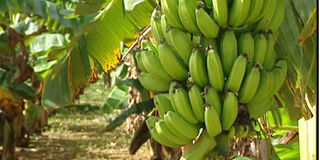What is the best fertiliser for bananas?

What is the best fertiliser for banana?
Irene Nakato
Dear Irene
Bananas are heavy feeders so they need to be regularly fertilised to be productive. There are a couple of ways to feed the plant.
When fertilising a mature banana plant, use 1 ½ kilogrammes of organic fertiliser per month. Dig this amount in and around the plant and allow it to dissolve each time the plant is watered.
Mix the fertiliser with the water and apply as you irrigate. If you are choosing to use high nitrogen and high potassium fertilisers, the method is a bit different.
Add the high nitrogen to the soil once a month during the growing season at full dose, according to the manufacturer’s directions.
When the plant begins to flower, cut back on the high-nitrogen fertiliser and switch to one that is high in potassium. Stop fertilising if the soil has a pH of 6.0 or under or when the plant begins to fruit.
Answered by Dr Settumba Mukasa a banana agronomist.
How an I sterilise soil?
Amos Bigirwa
Dear Amos
Sterilisation of soil is a standard method for organic farming. For a new farmer, making garden soil sterile may sound weird and challenging.
But, it is not so. You can accomplish the process by the following methods.
Container gardening using sterilised soil is an easy approach to maintaining healthy plants.
You can either sow seeds or transplant seedlings directly in the pots containing sterile soil.
Unfortunately, the potting mixture labeled as sterile usually comes along with insect eggs, soil fungus and weed seeds.
So, it is good to sterilise soil in your garden with simple steps.
As for the process, it is easy and more importantly, the amount of soil to be treated is manageable. The steps to follow for sterilising potting soil on your own are explained below.
• Like other sterilisation methods, heat is used to sterilise potting soil. And we can sterilise soil at home by using a gas grill or oven.
• For both the cases, the preparatory steps remain the same. So, you can choose a convenient method.
• If you are preparing homemade potting mix, do the necessary mixing, i.e., adding farmyard compost and manure to the soil. The final amount should be ideally five cups.
• For the ready-made potting media, you can proceed to the next step directly.
• Fill the potting mixture in a roasting bag.
• Pour some water (about 1 cup) in the bag and mix thoroughly to make the soil moist (not soggy or wet).
• Tie the bag properly with a string and allow it to settle over a roasting or meal baking pan.
• The next step is to poke two to three small holes on the top side of the bag. These holes allow steam to escape freely and help in reducing pressure buildup inside the bag.
• In one of the holes, you can insert a meat thermometer, so that it reaches the soil.
One word of caution concerning sterilisation of potting soil is that the grill temperature should not exceed 180° F.
It may take about two hours to reach the desired sterilising temperature.
Make sure you keep strict watch over the temperature reading.
Answered by Luke Busingye, soil expert
Help me find market for my fertiliser
I am an avid reader of Seeds of Gold and appreciate your good work. Kindly advise on where I can sell my fertiliser.
Bruce Ateenyi Ategeka
Dear Bruce
You have not specified the type of fertiliser you intend to sell. However, you can advertise the fertiliser in newspapers and magazines, social media, radio stations or even TV.
This will make farmers aware of your product. Afterwards, you can make the fertiliser available in Agrovets countrywide.
Answered by Peter Asaba Byona, an agronomist.
Flushing and steaming
What is the difference between flushing and steaming up in sows and gilts?
Gorrettie Tindie
Dear Stephen
Flushing is the additional feed given to gilts or sows before breeding or mating to increase the chances of conception two weeks before the breeding or mating day whereas steaming up is the additional feed rich in protein offered to sows or gilts two weeks before farrowing or giving birth in attempt to promote maximum milk production and increase piglets birth weight.
Answered by M Maimuna a livestock expert




